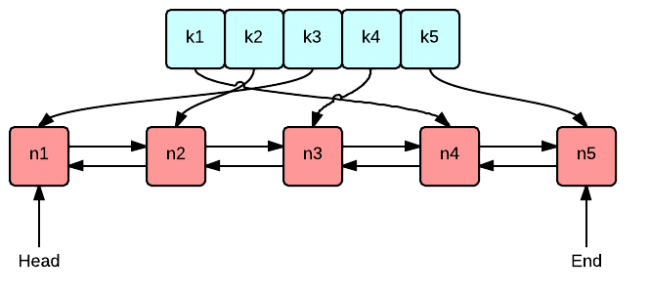手把手教你写LRU算法
一. 介绍
什么是缓存? 我们为什么需要它?
缓存是操作系统按顺序维护的页面缓冲区,以避免昂贵的内存访问操作。 通常,缓存比主内存快得多。 由于高速缓存的大小与主内存相比非常小,因此有可能需要在高速缓存和主内存之间交换页面。 每当在高速缓存中找不到需要从主存储器中导入的页面时,该页面就称为高速缓存未命中。 LRU缓存实现是一种FIFO策略,用于最大程度地减少缓存未命中。
当引用了缓存中不存在的新页面时,如果缓存已满,则使用最近最少使用高速缓存方案来删除最近最少使用的页面。 如果页面在缓存中,则将其移到缓存的开头。 因此,缓存按引用顺序存储页面。

LRU缓存使用以下数据结构实现:
双向链表:使用双向链表将高速缓存实现,链表大小就是缓存的大小。 最近使用的页面在链表的前端附近,最少使用的页面在链表的后端附近。
HashMap:它将节点的地址存储在缓存中。 它有助于在O(1)时间中找到节点地址。
具体的使用方法如下:
CustomizedLRUCache cache = new CustomizedLRUCache(2);
cache.put(1, 1); // 缓存是 {1=1}
cache.put(2, 2); // 缓存是 {1=1, 2=2}
cache.get(1); // 返回 1
cache.put(3, 3); // 该操作会使得关键字 2 作废,缓存是 {1=1, 3=3}
cache.get(2); // 返回 -1 (未找到)
cache.put(4, 4); // 该操作会使得关键字 1 作废,缓存是 {4=4, 3=3}
cache.get(1); // 返回 -1 (未找到)
cache.get(3); // 返回 3
cache.get(4); // 返回 4算法流程
当引用页面时:
- 检查页面是否在缓存中,如果页面在内存中,移除节点并将其置于链表的最前面。
- 如果页面不在缓存中,如果队列未满,则在队列的前面添加一个新节点,并更新哈希中的相应节点地址。 如果队列已满,请从队列的后面移除节点,然后将新节点添加到队列的前面。
二. 实现
我们可以借助Java原有的数据结构LinkedHashMap来实现,也可以自定义数据结构来实现。当然对于后者,我是更推荐的!先来介绍一下自定义的数据结构实现方法。
(1) DoubleLinkedList + HashMap
这里我们将页面定义为Node类型的数据结构,其中Node类中包含键和值两个属性:
class Node {
int key, val;
Node pre, next;
public Node(int key, int val) {
this.key = key;
this.val = val;
}
}定义好了页面,我们现在来定义存储页面的链表,双向链表:
class DoubleLinkedList {
private Node head, tail;
private int capacity;
public DoubleLinkedList() {
this.head = new Node(0, 0);
this.tail = new Node(0, 0);
this.head.next = this.tail;
this.tail.pre = this.head;
this.capacity = 0;
}
// 在链表的最后添加节点
public void addLast(Node node) {
node.pre = tail.pre;
node.next = tail;
tail.pre.next = node;
tail.pre = node;
capacity += 1;
}
// 删除某个节点
public void remove(Node node) {
node.pre.next = node.next;
node.next.pre = node.pre;
capacity -= 1;
}
// 移除首节点(后续的换出最少使用的节点使用)
public Node removeFirst() {
if (head.next == tail)
return null;
Node first = head.next;
remove(first);
return first;
}
// 返回当前容器的大小
public int size() {
return capacity;
}
}所以,我们有了基础的数据结构。有了双向链表的实现,我们只需要在 LRU 算法中把它和哈希表结合起来即可,先搭出代码框架:
class CustomizedLRUCache {
private DoubleLinkedList cache;
private HashMap<Integer, Node> map;
private int capacity;
public CustomizedLRUCache(int capacity) {
cache = new DoubleLinkedList();
map = new HashMap<>();
this.capacity = capacity;
}
/**
* LRUCache的put()方法
*
* @param key
* @param value
*/
public void put(int key, int value) {
...
}
/**
* LRUCache的get()方法
*
* @param key
* @return
*/
public int get(int key) {
...
}
}先不慌去实现 LRU 算法的 get 和 put 方法。由于我们要同时维护一个双链表 cache 和一个哈希表 map,很容易漏掉一些操作,比如说删除某个 key 时,在 cache 中删除了对应的 Node,但是却忘记在 map 中删除 key。
解决这种问题的有效方法是:在这两种数据结构之上提供一层抽象 API。
说的有点玄幻,实际上很简单,就是尽量让 LRU 的主方法 get 和 put 避免直接操作 map 和 cache 的细节。我们可以先实现下面几个函数:
/**
* 将已有的键刷新为访问过
*
* @param key
*/
private void makeRecently(int key) {
Node x = map.get(key);
cache.remove(x);
cache.addLast(x);
}
/**
* 使新的节点变为最新访问
*
* @param key
* @param val
*/
private void addRecently(int key, int val) {
Node x = new Node(key, val);
cache.addLast(x);
map.put(key, x);
}
/**
* 遍历当前map中的页面
*/
public void currentState() {
Iterator<Integer> iterator = map.keySet().iterator();
while (iterator.hasNext()) {
int key = iterator.next();
Node node = map.get(key);
System.out.print("[" + key + "->" + node.val + "]");
}
System.out.println();
}然后我们就来实现get和put方法
/**
* LRUCache的get()方法
*
* @param key
* @return
*/
public int get(int key) {
if (!map.containsKey(key))
return -1;
makeRecently(key);
return map.get(key).val;
}/**
* LRUCache的put()方法
*
* @param key
* @param value
*/
public void put(int key, int value) {
// 更新已有的键值
if (map.containsKey(key)) {
Node x = map.get(key);
cache.remove(x);
map.remove(key);
addRecently(key, value);
return;
}
// 缓存已满,置换出最少使用的键值对
if (capacity <= cache.size()) {
Node node = cache.removeFirst();
map.remove(node.key);
}
// 添加新的键值对
addRecently(key, value);
}最后将代码进行整合,得到如下代码:
import java.util.HashMap;
import java.util.Iterator;
class Node {
int key, val;
Node pre, next;
public Node(int key, int val) {
this.key = key;
this.val = val;
}
}
class DoubleLinkedList {
private Node head, tail;
private int capacity;
public DoubleLinkedList() {
this.head = new Node(0, 0);
this.tail = new Node(0, 0);
this.head.next = this.tail;
this.tail.pre = this.head;
this.capacity = 0;
}
public void addLast(Node node) {
node.pre = tail.pre;
node.next = tail;
tail.pre.next = node;
tail.pre = node;
capacity += 1;
}
public void remove(Node node) {
node.pre.next = node.next;
node.next.pre = node.pre;
capacity -= 1;
}
public Node removeFirst() {
if (head.next == tail)
return null;
Node first = head.next;
remove(first);
return first;
}
public int size() {
return capacity;
}
}
class CustomizedLRUCache {
private DoubleLinkedList cache;
private HashMap<Integer, Node> map;
private int capacity;
public CustomizedLRUCache(int capacity) {
cache = new DoubleLinkedList();
map = new HashMap<>();
this.capacity = capacity;
}
/**
* LRUCache的put()方法
*
* @param key
* @param value
*/
public void put(int key, int value) {
// 更新已有的键值
if (map.containsKey(key)) {
Node x = map.get(key);
cache.remove(x);
map.remove(key);
addRecently(key, value);
return;
}
// 缓存已满,置换出最少使用的键值对
if (capacity <= cache.size()) {
Node node = cache.removeFirst();
map.remove(node.key);
}
// 添加新的键值对
addRecently(key, value);
}
/**
* LRUCache的get()方法
*
* @param key
* @return
*/
public int get(int key) {
if (!map.containsKey(key))
return -1;
makeRecently(key);
return map.get(key).val;
}
/**
* 将已有的键刷新为访问过
*
* @param key
*/
private void makeRecently(int key) {
Node x = map.get(key);
cache.remove(x);
cache.addLast(x);
}
/**
* 使新的节点变为最新访问
*
* @param key
* @param val
*/
private void addRecently(int key, int val) {
Node x = new Node(key, val);
cache.addLast(x);
map.put(key, x);
}
public void currentState() {
Iterator<Integer> iterator = map.keySet().iterator();
while (iterator.hasNext()) {
int key = iterator.next();
Node node = map.get(key);
System.out.print("[" + key + "->" + node.val + "]");
}
System.out.println();
}
}编写main方法对算法进行测试:
public class Main {
public static void main(String[] args) {
CustomizedLRUCache cache = new CustomizedLRUCache(2);
cache.put(1, 1);
cache.put(2, 2);
cache.currentState();
cache.put(1, 3);
cache.currentState();
cache.put(3, 3);
cache.currentState();
cache.put(4, 4);
cache.currentState();
cache.get(3);
cache.put(1, 1);
cache.currentState();
}
}使用cache.currentState();来输出链表中的状态,这样可以实时看到链表中数据的变化。
输出的结果我们可以看到:
[1->1][2->2]
[1->3][2->2]
[1->3][3->3]
[3->3][4->4]
[1->1][3->3](2) LinkedHashMap
import java.util.LinkedHashMap;
class LRUCache {
private LinkedHashMap<Integer, Integer> cache;
private int capacity;
public LRUCache(int capacity) {
this.capacity = capacity;
cache = new LinkedHashMap<>();
}
public int get(int key) {
if(!cache.containsKey(key))
return -1;
makeRecently(key);
return cache.get(key);
}
public void put(int key, int value) {
if(cache.containsKey(key)){
cache.put(key, value);
makeRecently(key);
return;
}
if(capacity <= cache.size()){
int oldKey = cache.keySet().iterator().next();
cache.remove(oldKey);
}
cache.put(key, value);
}
public void makeRecently(int key){
int val = cache.get(key);
cache.remove(key);
cache.put(key, val);
}
}这个方法实现还是比较简单!
本博客所有文章除特别声明外,均采用 CC BY-SA 4.0 协议 ,转载请注明出处!